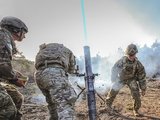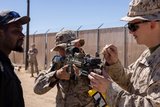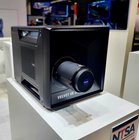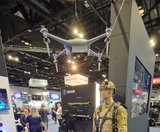ARA develops alternative to traditional flash-bangs
ARA has developed a new Non-Pyrotechnic Diversionary Device (NPDD) in order to give tactical teams an advantage in situations where the use of a pyrotechnic flash-bang is a poor or nonexistent choice.
The device has been developed to eliminate the exposure to hazardous toxins and inhalants common to pyrotechnic devices. The NPDD is a non-toxic, intrinsically safe diversionary device that uses a combination of non-pyrotechnic light and blast elements to create a distraction with similar effect to conventional pyrotechnic flash-bang devices with light and sound.
The NPDD features interchangeable burst caps, so the acoustic impulse and concussive force are customisable. The NPDD also features a customisable flash sequence and fuze delay, and is submersible for maritime operations.
The device uses compressed CO2 to pressurise a replaceable bursting cap to produce diversionary concussive force and acoustic impulse with a peak sound pressure level of 165 decibels. The NPDD uses LEDs and a replaceable COTS battery with supercapacitors to produce an ultra-bright flash of light.
In addition, the NPDD does not create any obscuring smoke or release hazardous toxins or inhalation hazards, making it ideal for repeated use in a training environment.
The NPDD can be used in training situations where the NPDD is typically less expensive per use and eliminates exposure to hazardous toxins and inhalants; in situations that would normally preclude the use of traditional pyrotechnic flash-bang devices (due to, for example, personnel injury concerns, fire hazards and sensitive materials); and in training or operational scenarios conducted in smaller spaces, where the full intensity of a standard flash-bang is not needed, or may be dangerous.
More from Training
-
![Cubic tailors mortar simulator for the US Army]()
Cubic tailors mortar simulator for the US Army
The company’s mortar trainer received improvements based on soldier’s feedback.
-
![Saab expands footprint in the US]()
Saab expands footprint in the US
The company will operate in two new locations in the coming years to better support US services.
-
![How terrain management capabilities can improve military training]()
How terrain management capabilities can improve military training
This type of tool provides more realistic training easing the incorporation of new scenarios that accurately represent the threats of the battlefield.
-
![I/ITSEC 2024: Australian Army approaches second phase of countermining training]()
I/ITSEC 2024: Australian Army approaches second phase of countermining training
The Engineering Corps has been conducting individual instruction using FLAIM Systems’ Sweeper and should start collective deployments in 2025.
-
![I/ITSEC 2024: Zeiss introduces Velvet 4K SIM projector for night flight simulation]()
I/ITSEC 2024: Zeiss introduces Velvet 4K SIM projector for night flight simulation
The next-generation platform is motion-compatible and can be used in OTW and NVG applications.
-
![I/ITSEC 2024: Saab introduces UAV live training capability]()
I/ITSEC 2024: Saab introduces UAV live training capability
The system can be used to prepare soldiers for both drone offensive operations and CUAS missions.

























